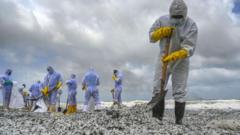Four years have passed since the X-Press Pearl cargo ship disaster led to Sri Lanka’s worst plastic spill, yet local volunteers still find themselves collecting harmful microplastics from the coastline. Billions of plastic pellets known as nurdles have invaded the beaches alongside other hazardous materials, causing dire environmental concerns.
The immediate aftermath was severe, as the nurdles blanketed the shores, leading to numerous marine deaths. However, current scientific assessments indicate that the effects of this disaster may be more persistent than initially believed. Efforts to clean up the coastline have seen hundreds of millions of nurdles removed, but the left-behind microplastics have become increasingly challenging to track and extract from the sand.
Research from Manchester Metropolitan University suggests that these microplastics are developing heightened toxicity, absorbing pollutants from the ocean similar to “chemical sponges.” Nurdles serve as the base material for plastic goods and their transportation can lead to significant spills, as was the case with the X-Press Pearl. The incident began with a nitric acid leak shortly after the ship set sail, leading to a series of unfortunate events where emergency relief efforts failed. Consequently, the vessel caught fire and sank, releasing its toxic cargo into the surrounding waters.
Muditha Katuwawala, an environmentalist and member of the local cleanup NGO, Pearl Protectors, describes the aftermath as nothing short of catastrophic. The visible effects included dead turtles and dolphins, with many exhibiting physical trauma related to the spill. The clean-up efforts initially yielded impressive results, but have since dwindled as the nurdles have become buried deeper in the sand.
Recent studies on fish in the region reveal hazardous metal contamination that mirrors the pollutants from the ship's cargo. Some local fishermen have reported a stark decline in fish numbers since the disaster, highlighting the economic toll on those reliant on marine resources for their livelihood.
In terms of reparations, the ship owner, X-Press Feeders Ltd, claims to have invested over $150 million to address the disaster. However, the Sri Lankan government argues these funds are insufficient to combat the long-term repercussions and has sought additional compensation, with court proceedings ongoing.
An expert committee has estimated the complete financial toll of the disaster may exceed $6 billion, factoring in loss of wildlife, tourism, and health impacts. Despite these assertions, the shipping company disputes the findings, and local authorities have continued to distance themselves from liability.
As livelihoods are jeopardized, many fishermen like Jude Sulanta are left with few options. Sulanta notes a worrying trend of fishermen selling their boats in search of alternative livelihoods or emigration, unsure if they will ever see justice served for the environmental harms incurred by the disaster.




















